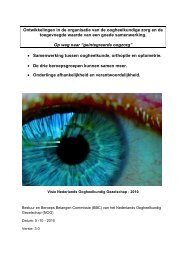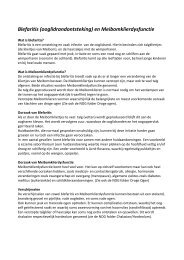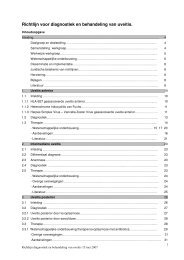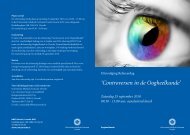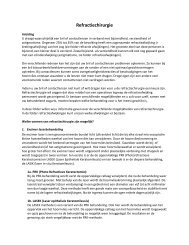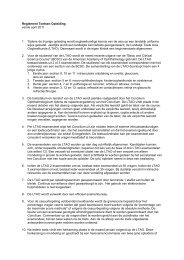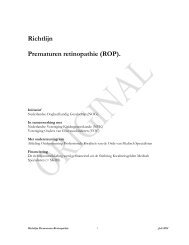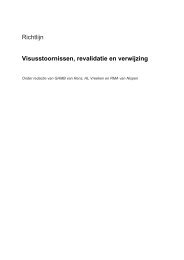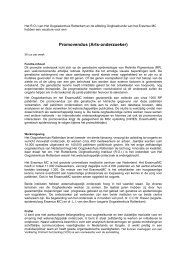terminology and guidelines for glaucoma ii - Kwaliteitskoepel
terminology and guidelines for glaucoma ii - Kwaliteitskoepel
terminology and guidelines for glaucoma ii - Kwaliteitskoepel
You also want an ePaper? Increase the reach of your titles
YUMPU automatically turns print PDFs into web optimized ePapers that Google loves.
1.3 - OPTIC NERVE HEAD AND RETINAL NERVE FIBER LAYER<br />
The identification of structural, contour <strong>and</strong> color changes is best done stereoscopically. The pupil should be dilated<br />
whenever possible to facilitate the exam. Two methods allow <strong>for</strong> time-efficient <strong>and</strong> inexpensive stereoscopic examination<br />
of the posterior pole:<br />
• indirect fundus lens (78D or 90D) at the slit-lamp<br />
• direct fundus lens (central part of Goldmann <strong>and</strong> Zeiss 4-mirror, Hruby) at the slit-lamp<br />
Fig. 1<br />
Different optic nerve head contours: A) normal ONH,<br />
B) <strong>glaucoma</strong>tous ONH, C) tilted ONH.<br />
The direct ophthalmoscope can give three-dimensional<br />
in<strong>for</strong>mation using parallax movements. It is essential to<br />
select a spot size with a diameter smaller than the diameter<br />
of the disc. This is to avoid light spreading from the peripapillary<br />
retina altering the colour appearance of the rim.<br />
The evaluation of the optic nerve head (ONH) <strong>and</strong> retinal<br />
nerve fiber layer (RNFL) may be divided into 2 parts:<br />
1.3.1 - Qualitative<br />
a) contour of the neuroretinal rim<br />
b) optic disc hemorrhages<br />
c) parapapillary atrophy<br />
d) bared circumlinear vessels<br />
e) appearance of the retinal nerve fibre layer<br />
1.3.2 - Quantitative<br />
a) optic disc size (vertical disc diameter)<br />
b) cup/disc ratio (vertical)<br />
c) rim/disc ratio<br />
d) retinal nerve fiber layer height (RNFLH)<br />
1.3.1.a - Contour of the neuroretinal rim<br />
With intact nerve fibers the contour of the rim depends on<br />
the shape of the optic disc canal (Fig. 1).<br />
The disc is usually slightly vertically oval. Black subjects<br />
often have larger discs as a result of a greater vertical disc diameter 1 .<br />
In normal discs with small cups the neuroretinal rim is at least as thick at the 12 <strong>and</strong> 6 o’clock positions as elsewhere<br />
<strong>and</strong> usually thickest (83% of eyes) in the infero-temporal sector, followed by the supero-temporal, nasal <strong>and</strong> then<br />
temporal sectors (I.S.N.T.) 2 . This pattern is less marked in larger discs, in which the rim is distributed more evenly<br />
around the edge of the disc (Fig. 2a, 2b).<br />
Optic cups are on average horizontally oval. However, large physiological cups in large discs tend to be more round<br />
than horizontally oval <strong>and</strong> the more vertically oval discs tend toward having a more vertically oval cup.<br />
Cupping tends to be symmetrical between the two eyes, the comparative vertical cup/disc ratio being within 0.2 in<br />
over 96% of normal subjects.<br />
Glaucoma is characterized by progressive thinning of the neuroretinal rim. The pattern of loss of rim varies <strong>and</strong> may<br />
take the <strong>for</strong>m of diffuse thinning, localized notching, or both in combination (fig. 2b). Thinning of the rim, while occuring<br />
in all disc sectors, is generally greatest at the inferior <strong>and</strong> superior poles, leading to a loss of the physiological rim<br />
shape so that the infero-temporal rim is no longer the thickest 3-7 .<br />
The optic cup often enlarges in all directions, but usually the enlargement occurs predominantly in the vertical direction,<br />
as a result of rim loss at the poles (Fig. 2b).<br />
Ch. 1 - 16 EGS



